Oleaceae - Botanical Family
| Number of plants found: 45 | Next | 
|
Go to page: | 1 | 2 | 3 | 4 | 5 |
Botanical name: Chionanthus virginicus
Common names: Fringe Tree, Old Man's Beard
Family: Oleaceae
Origin: Eastern United States











Panicles of creamy white fragrant flowers suspended from branches in May; male flowers are more showy; dark blue fruit attracts birds. Prefers moist, well drained soil.
Botanical names: Chrysojasminum floridum, Jasminum odoratissimum, Jasminum floridum, Jasminum fruticans
Common names: Showy Jasmine, Florida Jasmine, Yellow Jasmine, Fruity Jasmine
Family: Oleaceae
Origin: Mideterranean, Asia Minor











Small dark green pinnate foliage. Compact attractive shrub or climber with dark green leaves and bright yellow flowers that are 1" across, with the petals shaped into a shallow cup. Fragrance of this variety is very delicate and fruity. The flowers make a beautiful contrast with leaves. Blooms spring through fall, although in warm climates flowers may even appear in winter.
Botanical name: Forsythia sp.
Common name: Forsythi
Family: Oleaceae









The flowers are produced in the early spring before the leaves, bright yellow with a deeply four-lobed flower, the petals joined only at the base.
Botanical name: Jasminum adenophyllum
Common names: Bluegrape jasmine, Princess jasmine, Che vang, Lai la co tuyen
Family: Oleaceae
Origin: India









A rare endemic in Meghalaya State (India). Spreading fast growing vine with glossy large 2-3" dark green leaves similar to leaves of Jasminum Rex. Flowers are large, 2-3" wide, with narrow curled petels and extremely fragrant. Flower shape resembles Michelia Alba flower. Black-blue berries size of a small grape appear after blooming which attract birds. This species is very hard to find. Can be used il landscape as a fine vine or dense ground cover since is spreads fast and roots when touches the ground.
Botanical name: Jasminum aemulum
Common names: Palawan Jasmine, Malulee
Family: Oleaceae
Origin: Philippines







Palawan Jasmine (Jasminum aemulum) is a hardy evergreen shrub native to the island of Palawan in the Philippines. It can reach heights of 5-10 ft, with oblong leaves, shortly rounded at the apex and dark green in color on both surfaces. This handsome shrub produces numerous white, fragrant, 1-2 inch wide flowers that bloom all year round, making it a highly ornamental plant. The pleasant scent of these lovely white and off-white blooms often attract butterflies and hummingbirds.
This shrub can be grown in zones 9 to 11, requiring moderate watering and a sunny location. It can also be grown in colder regions as long as it is potted and sufficiently protected from the frost. The soil should be a mix of soil and potting mix, kept slightly moist and fertilized regularly with a balanced fertilizer. A light mulch of dead leaves is recommended to protect the plant from frost and maintain its distinctive appearance and fragrance.
Palawan Jasmine is easy to maintain and with proper care it will remain healthy, rewarding the owner with its beauty and memorable fragrance. Pruning the branches after flowering is necessary to allow for sufficient light and air circulation, whilst regular inspection for pests and diseases should also be carried out.
Botanical name: Jasminum angulare
Common name: South African Jasmine
Family: Oleaceae








Star-shaped, fragrant 1 inch flowers in summer. Three-part dark green glossy leaves, vining stems. Evergreen woody scandent shrub to train up a wall or as a wall shrub in a conservatory. Small lanceolate leaves in groups of three, summer flowers are fragrant, simple star shaped, white and held on the plant in vertical groups.
Botanical names: Jasminum azoricum, Jasminum trifoliatum Moench, Jasminum bahiense, Jasminum blandum, Jasminum hildebrandtii, Jasminum holstii
Common names: River Jasmine, Scrambling Vine, Jasmine De Trapo
Family: Oleaceae








.
Jasminum azoricum, also known as River Jasmine, is an evergreen climber with star-shaped white flowers and fragrant, summer-blooming blooms. Its dark green leaves are divided into three leaflets that not only provide a beautiful contrast to its white petals, but also give the plant a unique charm. The River Jasmine emits a heady, sensual aroma, making it a popular conservatory plant. It is also known by other synonyms such as Jasminum - lanatum, mauritianum, megalosiphon, pospischilii, rooseveltii, schroeterianum, tettense, uhligii, and zanzibariense.
The River Jasmine is remarkably versatile, as it can grow in various levels of sunlight and types of soil. In partial sun or semi-shade, or in full sun, the plant will thrive. River Jasmine prefers moist and well-drained soil, so regular watering is necessary for optimal bloom. Fertilizing the plant during its blooming period will also promote healthy growth. Grown in USDA Zones 9-11, the River Jasmine is a beautiful addition to any outdoor space, providing a splash of color with its off-white and white flowers. Not only this, but it's also an ideal place for songbirds, butterflies, and hummingbirds to visit, with its enticing aroma drawing them in.
For those who live in colder regions, the River Jasmine can be grown in a pot indoors. To best ensure healthy growth, the pot should be placed in a warm, sunny room that is away from drafts and sources of heat such as radiators and fireplaces. The pot should receive some direct sunlight for at least four hours a day. The soil should be kept moist, but not overly wet, and the plant should receive regular feedings of a balanced fertilizer. With proper care and maintenance, the River Jasmine will thrive, providing fragrant blooms throughout the year.
Botanical name: Jasminum dichotomum
Common names: Rose Bud Jasmine, Everblooming Jasmine, Gold Coast Jasmine
Family: Oleaceae










Rose Bud Jasmine (Jasminum dichotomum) is a large shrub or vining creeper, native to Africa and growing to a height of 5-10 ft. It features glossy, dark green leaves and offers clusters of fragrant white or off-white flowers throughout the year, attracting butterflies and hummingbirds.
Rose Bud Jasmine is best grown in well-drained, fertile soil in areas where full sun to partial shade is available. It requires regular watering, especially during hot, dry weather. Rose Bud Jasmine is generally hardy to USDA Zone 9-11.
In colder regions, Rose Bud Jasmine makes a great container plant. When growing in a pot, it is important to water regularly and provide indirect sunlight or partial shade. When temperatures drop below freezing, the pot should be moved to a sunny, warmer spot and well-draining soil should be used to prevent root rot. It is also important to remember to water Rose Bud Jasmine potted plants more during the winter months.
Botanical names: Jasminum fluminense, Jasminum azoricum var. fluminense
Common name: Wild jasmine
Family: Oleaceae
Origin: Tropical West Africa







It is a native species to various countries in Africa and Arabia; and an invasive species in parts of the Americas.
Evergreen, woody vine which climbs into tree canopies. Stalked leaves are opposite and trifoliate, with the terminal leaflet larger (to 7 cm long) than the other two (to 5 cm). Leaflets pubescent with pointed tips. Flowers white and fragrant, blooming at night in clusters at leaf axils, petals fused into a narrow tube with 5-7 terminal lobes in a star-shape. Fruit is a small, fleshy, round, black berry.
| Next |  |
Use link to repeat this search:
https://toptropicals.com/cgi-bin/garden_catalog/cat.cgi?search_op=and&keyword_op=and&language=e&family=Oleaceae&number=10
&no_change_lang=1&user=tt&sale=1&first=0









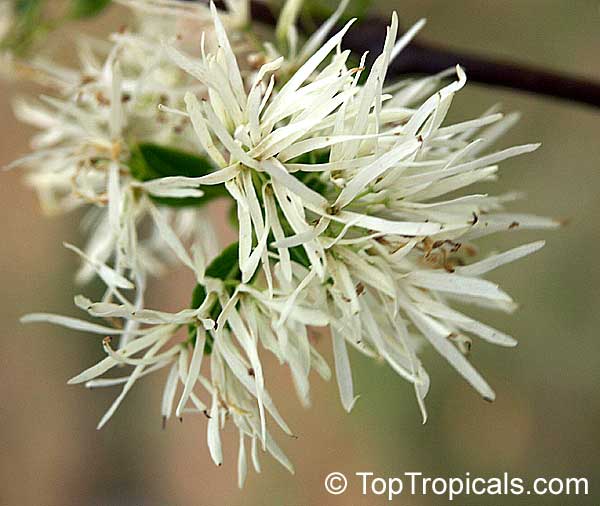



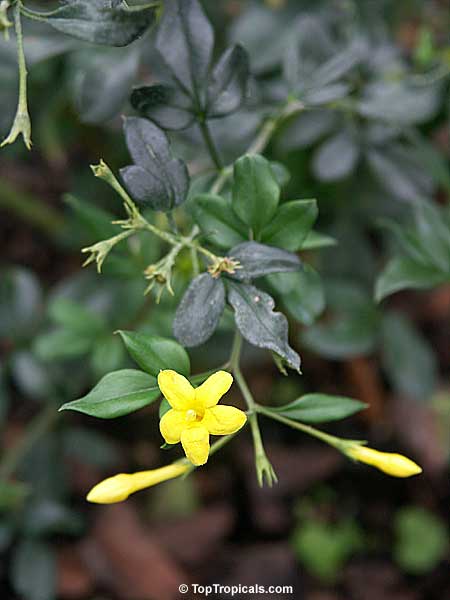









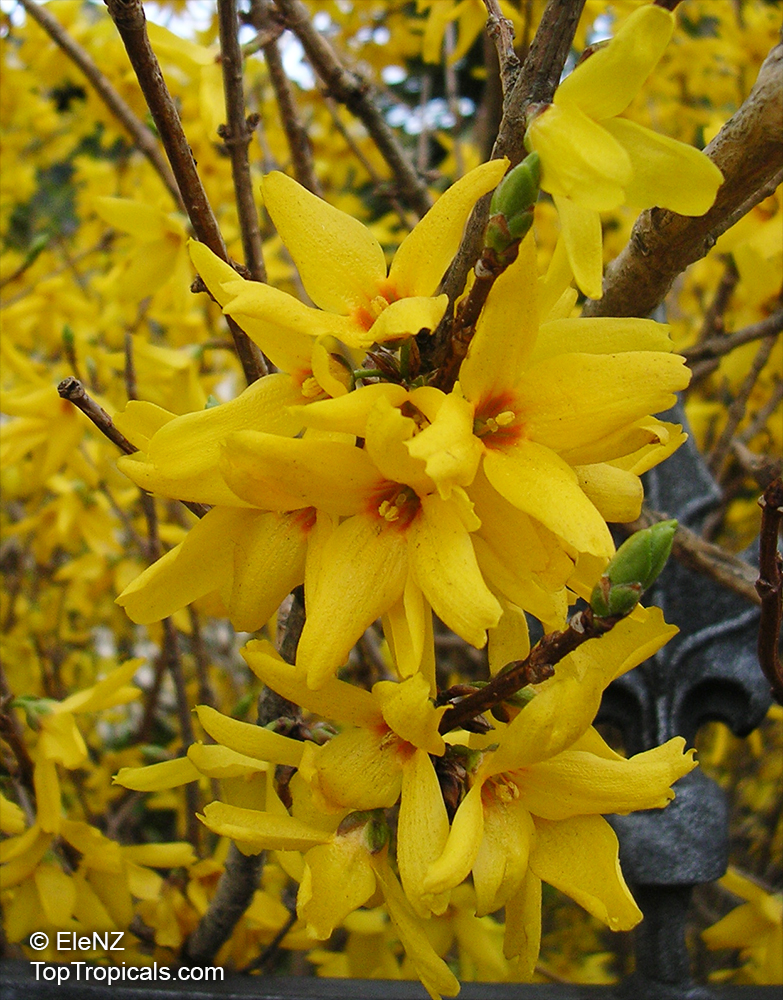
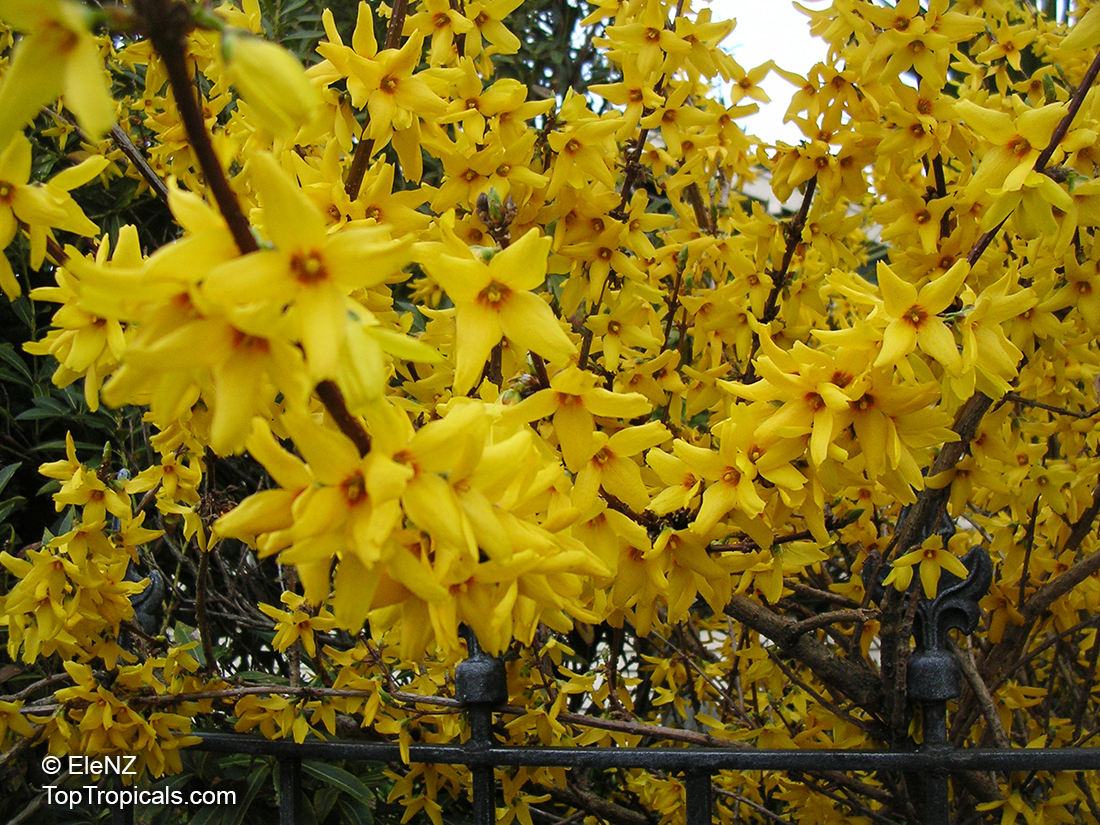












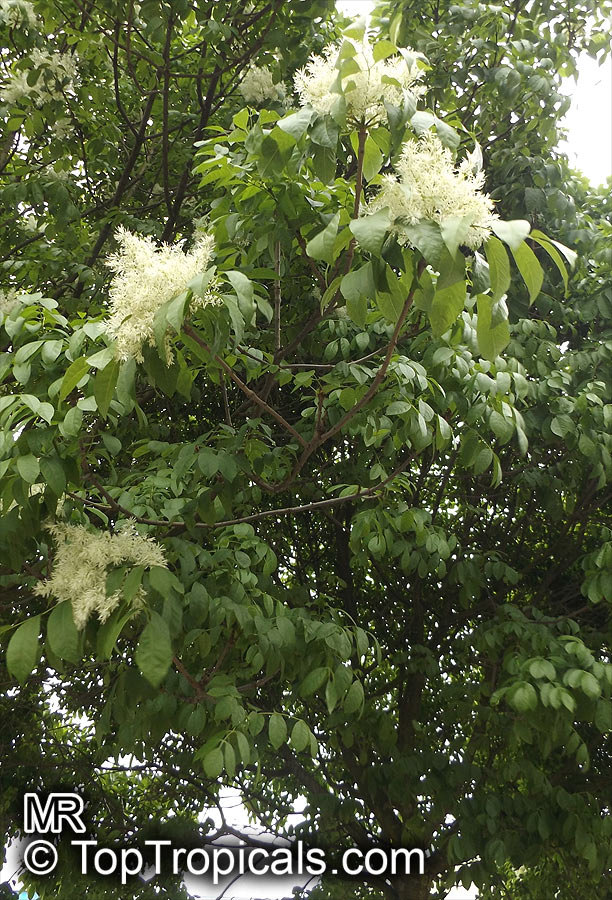




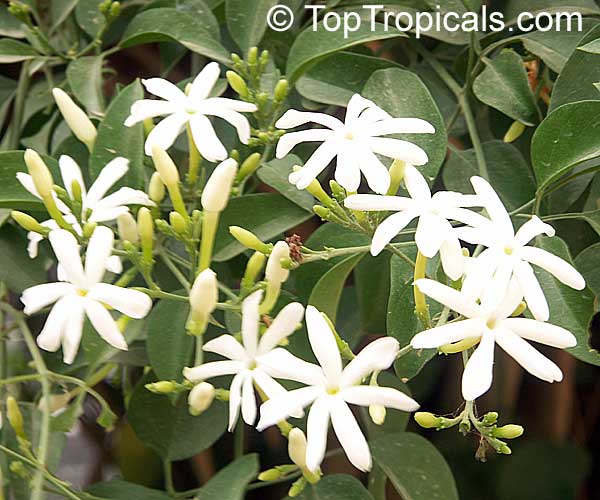

























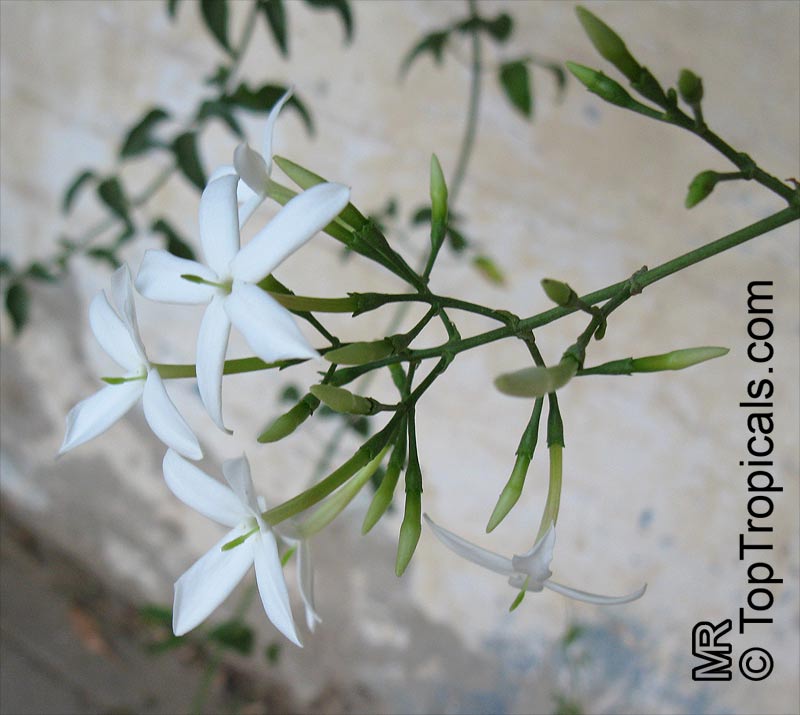
















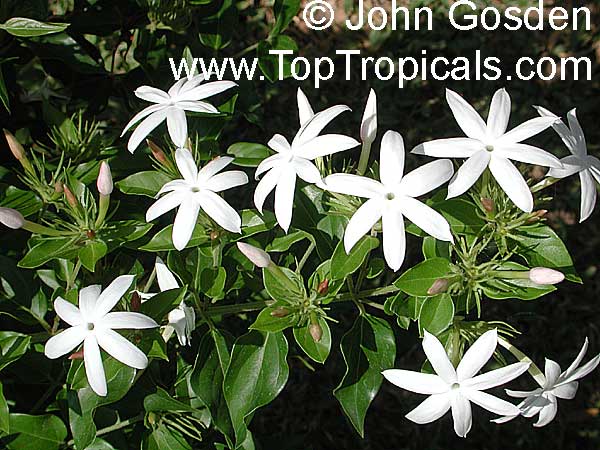





 SUNSHINE Pikake (NPK 2-2-4) - eco-friendly concentrated nutrition booster for fragrant flowers. Improves quantity and quality of flowers. Encourages profuse blooming. Increases flower fragrance intensity. Can be used with every watering. For best results, use in combination with
SUNSHINE Pikake (NPK 2-2-4) - eco-friendly concentrated nutrition booster for fragrant flowers. Improves quantity and quality of flowers. Encourages profuse blooming. Increases flower fragrance intensity. Can be used with every watering. For best results, use in combination with 
